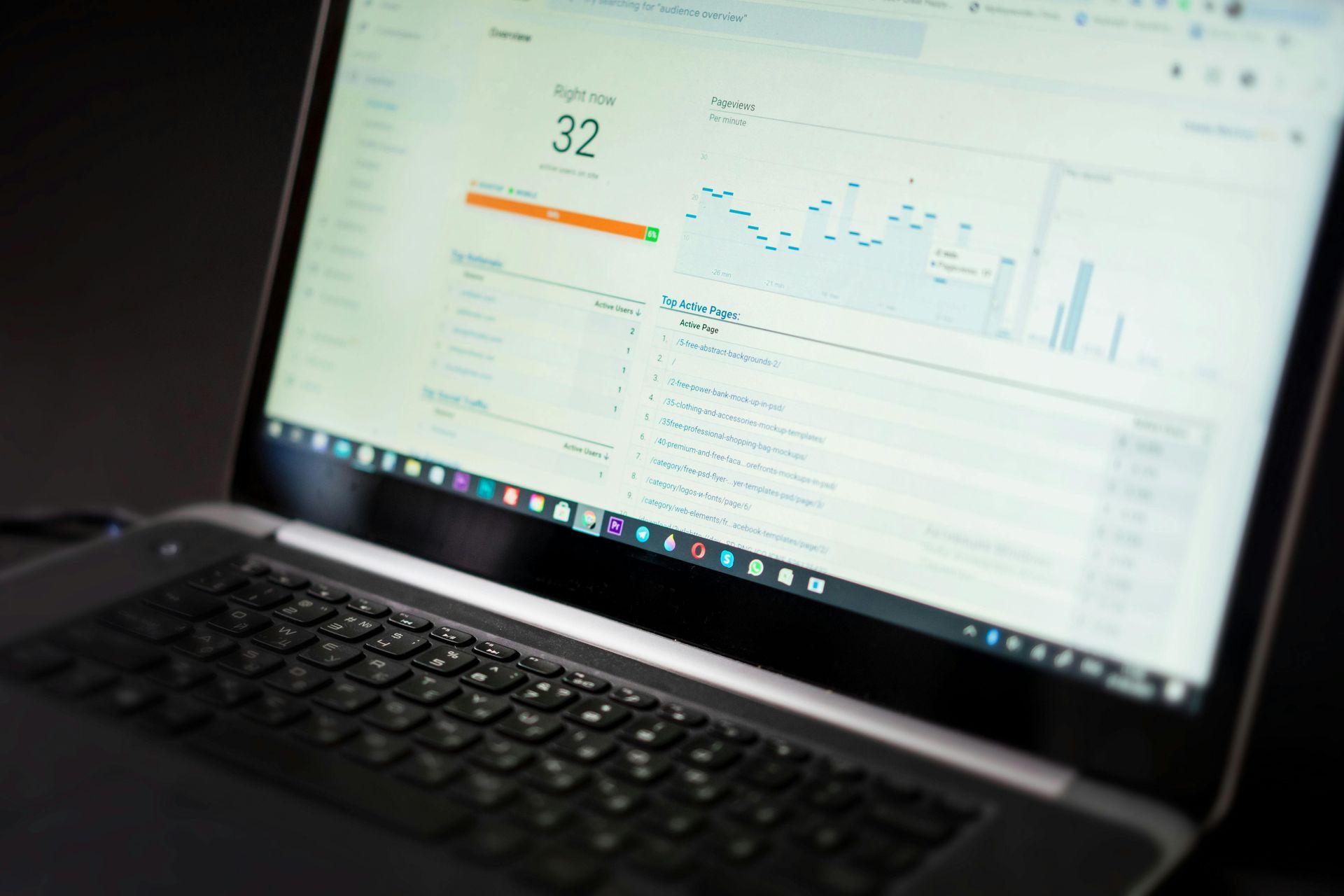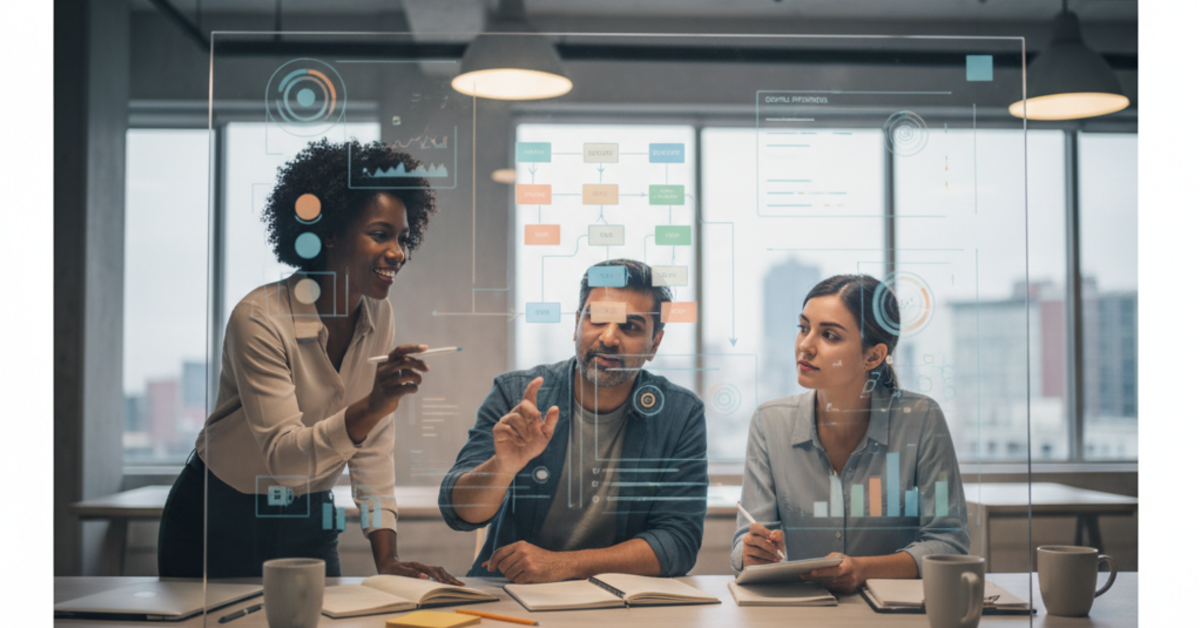
Is your website turning away potential customers instead of converting them? You're not alone. In 2025, 67% of SMEs struggle with digital products that fail to deliver real business results, despite having an online presence. For small and medium enterprises, the difference between surviving and thriving increasingly depends on the quality of your digital experience. It's no longer enough to simply exist online - your digital presence must actively work to attract customers and drive growth. At Digital Inspired, we've helped hundreds of businesses transform their digital presence into powerful growth engines. Here's our step-by-step guide to creating an SME digital experience that genuinely connects with customers and delivers measurable results. 1. Start With a Customer-First Strategy The most common mistake SMEs make is designing their digital presence around what they want to say rather than what their customers need. Begin by thoroughly understanding your customers' journey, pain points, and what they're really looking for when they interact with businesses like yours. Create detailed customer personas that capture not just demographics but also digital behaviours, preferences, and frustrations. What devices do they use? When are they most likely to search for your services? What problems are they trying to solve? This foundation ensures every design decision, content piece, and feature serves a real customer need rather than an internal preference. Your digital experience should solve problems for users, not create new ones. 2. Design an Intuitive User Journey Your website or app should guide visitors naturally toward their goals, whether that's making a purchase, booking a service, or finding information. Map out the entire user journey from first touch to conversion, identifying potential roadblocks and opportunities to delight. Key elements of an intuitive journey include: Clear, prominent calls-to-action that stand out visually Logical information architecture that mirrors how customers think Streamlined navigation with descriptive labels Simplified forms with only essential fields Visible contact information and support options Remember that confusion leads to abandonment. Every click should move users confidently toward their destination without requiring them to think about what to do next. 3. Prioritise Mobile-First Design In 2025, mobile traffic accounts for over 65% of web visits for most SMEs. Yet many businesses still design primarily for desktop, treating mobile as an afterthought. This approach severely limits your growth potential. Mobile-first design means beginning your design process with the mobile experience, then expanding to larger screens. This approach ensures your core functions work flawlessly on smaller devices, where most customers will encounter your brand. Focus on touch-friendly interfaces with appropriately sized buttons, simplified menus, and content prioritised for smaller screens. Ensure load times are lightning-fast - each second of delay on mobile increases bounce rates by 20%. The mobile apps we create follow these principles, resulting in engagement rates 3x higher than industry averages. 4. Create Content That Converts Your digital content should actively work to move customers through your sales funnel, not just fill space. Each piece of content needs a clear purpose aligned with a specific stage of the customer journey. For SME digital experiences, conversion-focused content includes: Benefit-driven headlines that speak directly to customer needs Concise, scannable text with bulleted lists and subheadings Social proof elements like testimonials, reviews, and case studies Visual content that demonstrates your product or service in action Clear next steps that guide users toward conversion Remember that your website visitors typically scan rather than read in detail. Make your key messages stand out visually and ensure they communicate value quickly. 5. Build in Personalisation Capabilities Personalisation has become essential for SME digital experience, with businesses implementing tailored content seeing conversion rates increase by up to 30%. Even with limited resources, you can incorporate simple personalisation strategies that make a significant impact. Start with these achievable personalisation tactics: Segment email communications based on previous interactions Display relevant product recommendations based on browsing history Tailor landing pages for different traffic sources Implement geolocation features to show local information Use cookies to welcome returning visitors differently As your digital maturity grows, you can implement more sophisticated personalisation through customer data platforms that create truly individualised experiences at scale. 6. Implement Analytics and Continuous Improvement A truly effective SME digital experience isn't static - it evolves based on real user data and behaviour. Implement comprehensive analytics that go beyond basic traffic metrics to understand how users actually interact with your digital products. Focus on these key performance indicators: Conversion rate by traffic source and device User flow and drop-off points in key journeys Engagement metrics (time on page, scroll depth, interactions) Form completion rates and abandonment points Return visitor rate and customer retention Use these insights to make regular, incremental improvements to your website or app. Even small optimisations can compound to create significant growth over time. 7. Connect All Digital Touchpoints Your customers don't experience your brand in silos - they move between your website, social media, email communications, and perhaps your mobile app. These touchpoints must work together to create a cohesive customer experience. Audit all your digital channels to ensure consistent messaging, visual identity, and user experience. Information captured in one channel should be accessible in others to create a seamless journey. Consider implementing these connected experience elements: Single sign-on across all digital properties Consistent product information across channels Shared customer service history between platforms Cross-platform notification systems Unified analytics to track cross-channel journeys This connected approach ensures customers receive consistent value regardless of how they choose to engage with your business. Transform Your Digital Presence for Meaningful Growth Creating an exceptional SME digital experience isn't about chasing trends or implementing flashy features. It's about thoroughly understanding your customers and building digital products that genuinely meet their needs while driving your business goals. The most successful SMEs approach digital experience as an ongoing programme of improvement rather than a one-time project. Each refinement brings you closer to a digital presence that not only attracts customers but converts and retains them. At Digital Inspired, we specialise in creating websites and mobile apps that don't just look good - they deliver measurable business results through thoughtful user journey optimisation, compelling design, and strategic functionality. Ready to transform your digital presence into a powerful growth engine? Let's talk about how we can collaborate to create digital experiences that truly represent your brand and connect with your ideal customers.

Your website is often the first place customers interact with your brand, which means it plays a crucial role in shaping how they see your business. When your design, messaging and visuals work together cohesively, they help build trust, recognition and loyalty. But when your website feels disconnected from your brand identity, it can confuse visitors and weaken the impact of your marketing efforts. Here’s how to ensure your website reflects your brand accurately and consistently. 1. Start With Clear Brand Foundations Before diving into website design, it’s essential to have your brand identity clearly defined. This includes your brand values, mission, personality, tone of voice and visual guidelines. If any of these are unclear, your website may end up feeling inconsistent or directionless. A strong brand foundation ensures that every design decision—colour, layout, photography or copy—supports a unified message. 2. Use Consistent Visual Elements Visual consistency is one of the quickest ways to strengthen brand identity. This includes using the same: Colour palette Typography Logo variations Icon styles Photography or illustration style These elements should be applied consistently across your website to create a seamless and recognisable brand experience. For example, a luxury brand might use elegant typography, a muted colour palette and sophisticated imagery, whilst a fun, youthful brand might lean towards bold colours and playful graphics. 3. Reflect Your Brand Personality in Your Layout Your website layout can communicate just as much about your brand as your colours and fonts. A minimalist design gives a modern, professional feel, whereas a more vibrant layout can make your brand appear energetic and creative. Consider what your brand stands for and choose a structure that mirrors that personality. Clean, simple layouts are ideal for brands focused on clarity and professionalism, while more dynamic layouts may suit lifestyle or creative brands. 4. Align Your Tone of Voice With Your Audience Brand identity isn’t just visual—it’s verbal too. The language you use on your website should align with your brand personality and speak directly to your audience. A financial firm might use a formal, authoritative tone, whereas a boutique bakery might adopt a warm, friendly voice. Consistent messaging across headings, product descriptions and calls to action helps build familiarity and strengthens brand trust. 5. Use Authentic, On-Brand Imagery Stock photos can work in some cases, but overused or generic images can dilute your brand identity. Where possible, use high-quality, original photography or custom illustrations that match your visual style and brand personality. This makes your website feel more genuine and memorable. 6. Ensure Your User Experience Reflects Your Values If your brand values simplicity, your site should be easy to navigate. If you champion innovation, users should experience fresh, modern interactions. User experience (UX) is a direct reflection of your brand—so every interaction should echo your core values. Ready to Build a Website That Truly Represents Your Brand? Aligning your website with your brand identity isn’t just a design choice—it’s a powerful strategy that boosts recognition, trust and conversions. At Digital Inspired , we specialise in creating websites that bring your brand to life online and connect with your audience from the moment they land on your page. Discover how we can elevate your brand at Digital Inspired and book your free consultation today.

In an age where anyone can create a website with a drag-and-drop tool, it’s easy to wonder whether investing in professional web design is really worth it. DIY platforms like Wix and Squarespace make it seem quick and affordable—but when it comes to long-term return on investment, there’s a clear difference between a site you build yourself and one crafted by experts. Here’s a closer look at how professional web design compares to DIY builders in terms of performance, conversions and business growth. 1. First Impressions and Brand Credibility DIY websites often rely on generic templates that hundreds of other businesses also use. While they can look tidy, they rarely capture your brand identity or communicate professionalism at a high level. A custom-designed website, on the other hand, is built around your message, tone and audience—instantly setting you apart and helping build trust. Customers judge a business in seconds, and a polished, bespoke website signals credibility and legitimacy right away. 2. Optimised for Conversions DIY sites tend to focus on how things look rather than how they perform. Without expert guidance, calls to action can be unclear, navigation confusing and page layout ineffective. A professionally designed site considers user experience from the ground up: Clear conversion paths Strategic placement of CTAs Mobile optimisation Accessibility compliance Faster load speeds These elements directly affect enquiries, sales and bookings—making a tangible difference to your ROI. 3. SEO and Visibility Search engines reward websites that are technically sound, mobile-friendly and fast. DIY builders offer basic SEO tools, but rarely provide the structure needed to rank competitively. Professional designers build with search performance in mind, setting up clean code, optimised pages and correct metadata—all of which help your business appear higher on Google and attract more organic traffic without relying on paid ads. 4. Long-Term Value vs. Short-Term Savings DIY sites may seem cheaper at first, but limitations soon appear: Hidden subscription costs Limited design flexibility Restricted functionality Poor scalability Extra fees for plugins or e-commerce features Professional design is an investment that pays for itself through better performance, higher conversions and long-term adaptability. Instead of outgrowing your site within a year, you get a platform built to grow with your business. 5. Support, Strategy and Peace of Mind With DIY builders, you’re responsible for everything—security updates, troubleshooting, layout changes and compliance. That takes time away from running your business. When you work with a web design agency, you gain strategic support, ongoing maintenance and expert insight into what works online—giving you both confidence and time back. So, What’s the Real ROI? A website built by professionals isn’t just a prettier version of a DIY template—it’s a sales tool engineered to convert visitors, build trust and support growth. While DIY options may suit hobbyists or startups testing an idea, businesses that want to scale see better profitability and long-term gains with expert design. At Digital Inspired , we specialise in websites that deliver measurable results—not just surface-level design. If you’re ready to turn your website into a high-performing business asset, we’re here to help. Explore how we can elevate your online presence at Digital Inspired and book a free consultation today .

Your website is more than just a place to showcase your business—it’s your most powerful sales tool. Whether you run a local shop, a professional service, or a growing e-commerce brand, your website is often the very first interaction potential customers have with you. And as we all know, first impressions count. At Digital Inspired, we’ve helped businesses of all sizes transform their websites into conversion-driven platforms. Here’s why your website should be working harder than any member of your sales team. It Works Around the Clock Unlike a physical shop or an office, your website never closes. It’s live 24/7, ready to welcome visitors, answer questions, and capture leads while you sleep. A well-designed website gives potential customers everything they need—product details, testimonials, pricing, and ways to get in touch—at the exact moment they’re looking for it. It Builds Trust Instantly People make snap judgements online. Research shows it takes just a few seconds for visitors to decide whether they trust your site. Clean design, professional branding, and clear messaging all contribute to that trust. Add in case studies, client reviews, and security badges, and you’ll quickly reassure hesitant visitors that your business is reliable. It Guides Visitors Towards Action A great website doesn’t just provide information—it encourages action. From booking a consultation to making a purchase, every page should guide visitors towards the next step in their journey. Effective calls to action (CTAs), strategically placed throughout the site, act like a virtual salesperson, nudging prospects closer to conversion. It Strengthens Your Brand Identity Your website is your digital shop window. Every colour, font, and image contributes to the way your brand is perceived. A strong, consistent design ensures that your business looks professional and memorable, helping you stand out from competitors. It Provides Measurable Results Unlike traditional marketing, where it’s hard to track exactly what’s working, your website gives you data you can use. Analytics tools reveal how people find your site, where they spend the most time, and where they drop off. This insight allows you to refine your strategy and continuously improve your results. Is Your Website Selling for You? The truth is, a website that isn’t optimised for conversions is a missed opportunity. It could mean potential customers are slipping away to competitors who have invested in better design and user experience. At Digital Inspired, we don’t just design websites that look good—we build sites that deliver measurable business results. From sleek, responsive designs to conversion-focused strategies, our goal is to make your website your strongest sales asset. Ready to turn your website into your best-performing salesperson? Visit Digital Inspired today and book a free consultation with our team.

Your website is often the first impression potential customers have of your business. No matter how good your product or service is, poor design choices can send visitors clicking away instead of converting into leads or sales. At Digital Inspired , we’ve seen firsthand how subtle design tweaks can dramatically improve performance. Below are ten common website design mistakes that may be costing you conversions—and how to fix them. 1. Slow Loading Times If your site takes longer than three seconds to load, most users will leave. Bloated images, unnecessary scripts, and cheap hosting are often the culprits. Speed optimization should be a top priority. 2. Cluttered Layouts Too much text, too many buttons, or distracting pop-ups overwhelm visitors. A clean, well-structured design guides the eye and keeps the focus on what matters: your offer. 3. Poor Mobile Experience Over 60% of web traffic now comes from mobile devices. If your site isn’t responsive or easy to use on smaller screens, you’re losing a huge portion of your audience. 4. Weak Calls to Action (CTAs) If visitors don’t know what to do next, they’ll leave. A strong CTA—like “Get Your Free Quote Today”—should be clear, visible, and action-oriented. 5. Confusing Navigation If users can’t find what they need within a few clicks, they’ll bounce. Keep menus simple and intuitive with clear labels and a logical hierarchy. 6. Overusing Stock Photos Generic stock images make your brand feel impersonal. Whenever possible, use authentic photography or custom graphics that reflect your business. 7. Lack of Trust Signals No testimonials, case studies, or security badges? Visitors need reassurance. Adding these elements builds credibility and increases conversions. 8. Ignoring Accessibility If your site isn’t accessible to people with disabilities, you’re excluding potential customers and risking legal issues. Good design is inclusive design. 9. Walls of Text Long paragraphs scare users away. Break content into short sections with headlines, bullet points, and visuals to keep readers engaged. 10. No Clear Value Proposition If visitors can’t quickly understand who you are, what you do, and why it matters to them, they’ll move on. Your homepage should communicate your value instantly. The Bottom Line A well-designed website isn’t just about looking good—it’s about guiding visitors toward action. By avoiding these common mistakes, you’ll create a smoother, more persuasive user experience that leads to more conversions. At Digital Inspired , we specialize in designing websites that don’t just impress—they perform. Whether you need a full redesign or a few strategic tweaks, our team can help turn your website into your best sales tool. Ready to stop losing conversions? Contact Digital Inspired today for a free consultation and discover how we can transform your website into a high-converting asset.

Artificial Intelligence (AI) is no longer a buzzword—it’s the backbone of innovation in web and mobile app development. In 2025, AI has moved far beyond experimental; it's embedded into every stage of the digital product lifecycle, from design and development to testing, personalisation, and post-launch optimisation. For modern agencies and startups alike, understanding how AI is reshaping the landscape is essential to staying competitive. Here’s a look at the most impactful ways AI is transforming web and mobile app development this year. Faster Prototyping and Design AI-powered tools like Figma AI, Uizard, and Framer allow developers and designers to generate wireframes, layouts, and entire user interfaces from simple text prompts. What used to take days can now be done in hours. Agencies can quickly produce interactive prototypes, reducing client feedback loops and accelerating time-to-market. Smarter Coding with AI Assistance Coding is being revolutionized by tools like GitHub Copilot and CodeWhisperer. These AI assistants help developers write code faster and with fewer errors, offering real-time suggestions, auto-completing functions, and even spotting security vulnerabilities. This is especially valuable for agencies juggling multiple tech stacks or tight project timelines. Automated Testing and QA Testing is a major bottleneck in most development workflows. AI now enables automated test case generation, bug detection, and regression testing. Tools like Testim and Functionize use machine learning to adapt to app changes over time—reducing manual QA effort and ensuring more reliable releases. Hyper-Personalised User Experiences AI lets apps dynamically adjust to user behavior. From personalised content recommendations to AI-driven UX adjustments, applications can now “learn” how users interact and tailor their experiences accordingly. This level of personalisation boosts engagement, retention, and overall user satisfaction. Natural Language Interfaces Voice and text-based AI interfaces are becoming standard. Whether through ChatGPT integrations or custom NLP models, apps can now offer conversational experiences—ideal for customer support, onboarding, or guiding users through complex workflows. This also expands accessibility for users with varying needs. Enhanced Data Insights Web and mobile apps generate a goldmine of user data. AI tools like Mixpanel with predictive analytics and Hotjar with AI heatmaps help teams understand user behavior, identify friction points, and prioritize improvements. Decisions are no longer guesswork—they’re data-driven and AI-informed. Final Thoughts In 2025, AI is not replacing developers or designers—it’s empowering them. The best agencies aren't just using AI tools; they’re integrating AI thinking into every aspect of their workflows. As client expectations rise and competition intensifies, the agencies that embrace AI-driven development will lead the pack. The future of web and mobile app development is intelligent, adaptive, and deeply collaborative—and it’s happening now, contact Digital Inspired for more information.














